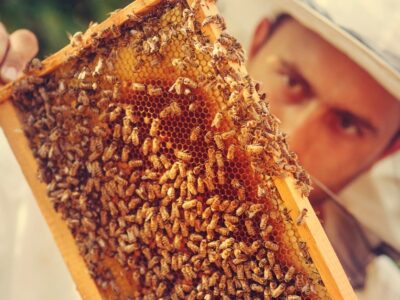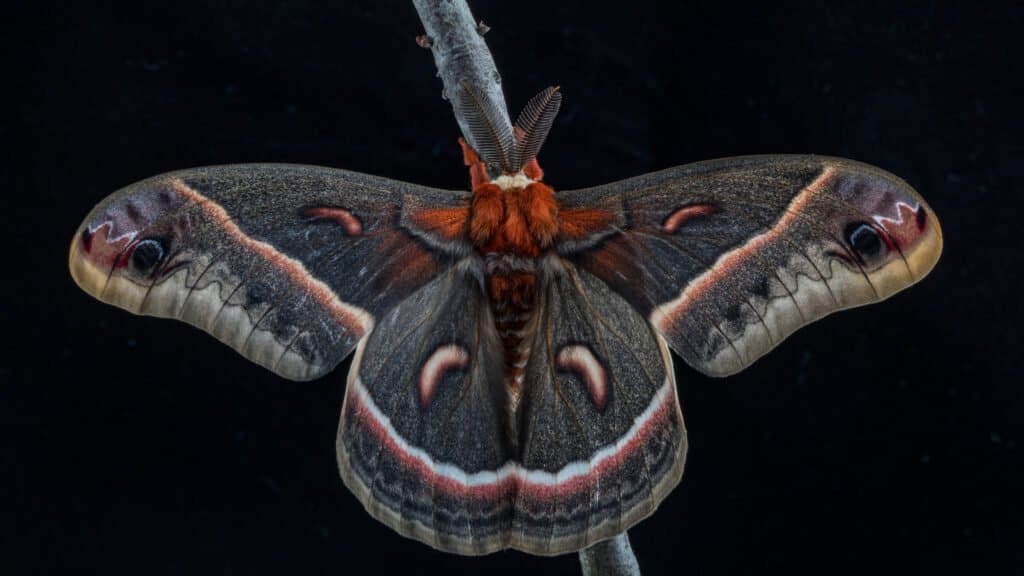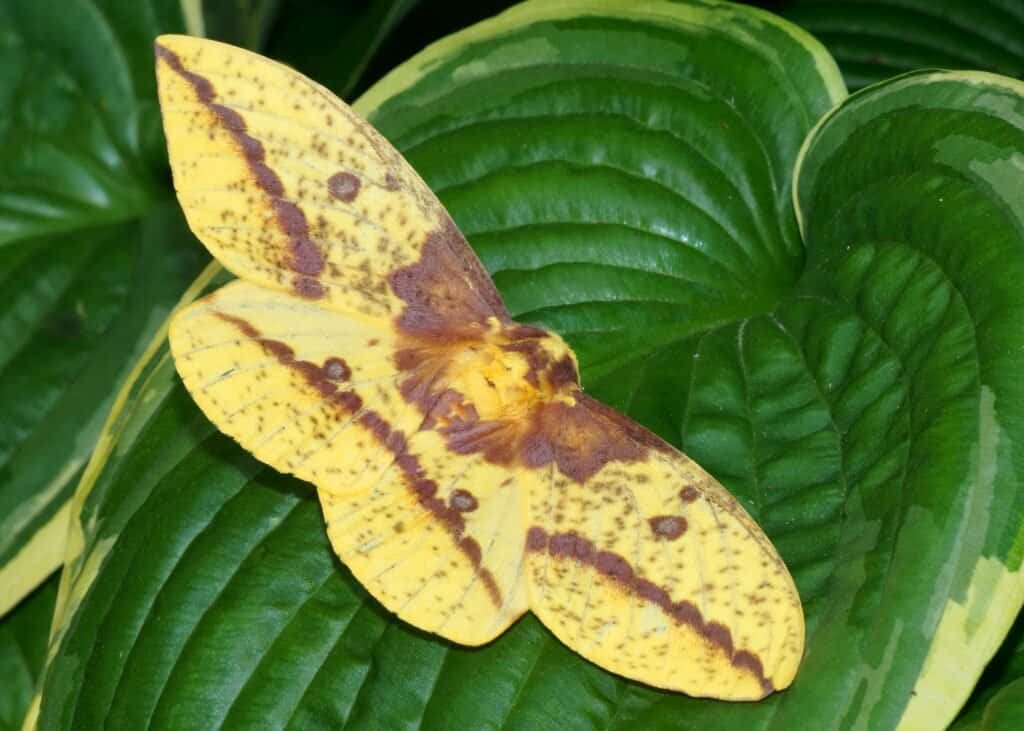How Big Can Moths Get
Numbering at over 160,000 species worldwide, moths are some of nature's near important pollinators. Moths and butterflies belong to the Lepidoptera insect order, and moths brand up 89-94% of the species. There are a few like shooting fish in a barrel distinctions you can look for to determine if you are looking at a moth or a butterfly.
The antennae are shaped differently with order-shaped antennae with a bulb on the ends. Moths have a feathery look with a jagged edge. Typically butterflies are more colorful, although many moths accept beautiful colors. Moths shed scales that look similar a powdery substance on your fingers if y'all touch them. It is natural for this shedding and does non affect the lifespan of the moth.
Moths mostly fly at night, but some species do fly during the daytime. They also fold their wings differently. Butterflies fold them toward their backs, and moths fold them over their abdomen. The life cycle is similar, with i significant distinction in the transformation process. A moth caterpillar volition build its cocoon out of silk-like substance. The butterfly caterpillar builds a hard chrysalis.
An important insect to ecosystems, pollinating more than any other insect, moths also pose problems for agriculture. For this reason, farmers utilise pesticides and herbicides to kill the moths and protect their crops. Runoff from the crops is endangering surrounding ecosystems and threatening the Lepidoptera population. Below you lot'll find 10 of the largest moths in the world as measured by their wingspan.
#10: Splendid Royal Moth (Citheroma Splendens)
Yous can detect this imperial dazzler forth the north edge of Mexico and the lower parts of the United states of america. The mating flavour is a short July-Baronial, having groups of 1-iv eggs at a time laid on a host leaf.
They are night greyness with red veins and white markings and adopt the tasty leaves of the wild cotton, manzanita, New United mexican states evergreen sumac, and squawbush.

They volition burrow in underground chambers in September for the pupa stage of the life cycle, re-emerging as a moth.
#9: Cecropia Silkmoth (Hyalophora Cecropia)

A cute specimen adorned with red, white, and yellowish wings, black "centre" markings, and a frosted appearance on the wings. The abdomen has bands of red and white. This moth has a wingspan of 5 ⅞ inches and an developed lifecycle of two weeks.
Found E of the Rocky Mountains, these moths similar the forests in the U.s.a. and Canada. The bolas spider tin mimic the pheromones of a female cecropia and will use the scent to draw male moths into their webs. The moths mate from March-July and, in specific areas, will mate May-June, and then repeat 2 weeks later.
#viii: Agapema Oculea & Agapema Polyphemus
Reaching a wingspan of nearly vi inches, the Agapema family has ii very like species. The Agapema oculea is tan with orange, blue, and black eyespots. There is a marginal black line, and in that location may exist a yellow or scarlet tint to the body. The Agapema polyphemus is carmine or yellowish-brown, while the underside has pink, brownish, or rust markings.
The Agapena oculea has one mating in June-August and lives in oak woodlands and mixed forests of Southwestern Us. The Agapena polyphemus mates once in the Northern United States from May-July, twice in the middle regions from Apr-May and once more in July-August, and several mating cycles throughout the Southern Us.
#7: Giant Silk Moths (Saturniids)

The giant silk moths include some species like: polyphemus moth (Antheraea polyphemus), luna moth (Actias luna), Columbia silk moth (Hyalophora columbia), and cecropia moth (Hyalophora cecropia), which nosotros've already detailed.
The color variations go from shades of brown, orange and yellow forming "eye spots" in the polyphemus moth to vivid light-green with pink/brown spots and tails on the hind wings in the luna moth, to dull, waxy dark-green with rows of orange, yellow, or blue adorning the wings in the Columbia silk moth, to a brighter colored cecropia moth.
Each of these produces silk that is harvested and used in silk production in Asian and South American cultures. The colors vary from white silk to lite brown, silverish dark-brown, and brownish, respectively.
These silk-producing moths have a wingspan of up to 6 inches and are native to deciduous pelting forests and wooded areas. When it is mating time, the female person moth will release pheromones for only ii-three hours, attracting males from several miles away.
#6 Largest Moth: Royal Walnut Moth (Citheroma Regalis)
The Royal Walnut Moth reaches up to a vi ¼ inch wingspan, and the larva has its own name, the hickory horned devil. This moth is native to the Southeast regions of the United States. An heady coloring, the moth has grey-green wings with orange striping and a series of xanthous dots. The trunk is orange with narrow yellow bands. This is a considerable change from the blue-green color of the moth in its caterpillar stage.
Mating only one generation per season, these moths adopt to lay their eggs on walnut, butternut, or hickory tree leaves. They will also use the leaves of persimmon, sweetgum, and sumacs. Some scientists believe that the larvae abound faster and larger on persimmon leaves.
#5: Majestic Moth (Eagles imperialis)

Matt Jeppson/Shutterstock.com
The regal moth or Eagles imperialis is primarily yellow with pinkish/purple-brownish patches and spots. Its wingspan can be as large as 6 ⅞ inches. The adults do not feed. They take flying after sunrise and will mate subsequently midnight on the same 24-hr bicycle. The females lay their eggs on a leaf, sometimes a unmarried egg, or in groups of 2-five eggs. Information technology takes about two weeks for the eggs to hatch.
The imperial moth tin be constitute effectually parts of the The states and Canada. Ane main difference betwixt males and females in the Imperial Moth is the antennae. The male antenna is quadripectinate, so narrowing down to a more unproblematic singular-looking antenna. The female does not take the quadripectinate but only has a singular-looking antenna.
Most Imperial Moths emerge in late summer. This timing helps with their natural defense against predators. Their colors allow them to blend in with falling leaves that ofttimes share similar colorings. The moth is commonly constitute on the woods floor with the leaves. When you meet these moths collected near lights, it will probable exist the females who have already mated and laid their eggs.
#4: Giant Wood Moth (Endoxyla Cinera)
It is very unusual to find one of these mammoth-sized moths. The wingspan is measured at ix.8 inches and is said to be the heaviest moth globally, weighing in at just over an ounce. These moths exist along the coast of Queensland and New South Wales. Attracted to the softwood of a eucalyptus, the larval stage ranges from i-3 years and has a imperial and white banding. This coloring goes away as they mature.
The adult is grey and has a brusque life bike, living only a few days before laying eggs and dying. The females practice non consume and survive on reserves stored upwardly while in the larva stage. The females exercise not wing well, so they are found resting on tree trunks or wooden objects like fence posts.
#three: Atlas Moth (Attacus Atlas)

Cocos.Bounty/Shutterstock.com
If you are in Southeast Asia, you lot might run across an Atlas Moth. An intimidating wingspan of x-12 inches brings this moth about the top of our list. The intricate colors and patterns on the wings include reddish-brown with white, black, pink, and royal designs. The underside is paler in color.
It is thought that these moths have a defense against predators strategy built into their colorful pattern. The tips of the wings resemble the heads of snakes, which would ward off enemies. During the caterpillar stage, they will spray secretions much like skunks when predators are nearby.
#2: White Witch (Thysania Agrippina)
Native to South America, Mexico, and Texas, the White Witch has a wingspan of 11.4 inches. A rare sight, primarily due to its power to alloy in with trees, the White Witch has a zigzag pattern with shades of brown, black, or grey. This beautiful moth is also called Birdwing Moth, Ghost Moth, Great Owlet Moth, and Dandy Grey Witch Moth. The life of a White Witch is ane-2 weeks.
#1 Largest Moth: Hercules Moth (Coscinocera Hercules)

This impressive species has a wingspan of 10.6 inches, with females growing upwardly to 14.ii inches. That wingspan of over 14 inches makes Hercules moths the largest moth species in the earth! They are located in North Queensland and New Guinea. The life bridge is a short ii-8 days since they do not have usable mouths to feed. They alive long plenty to mate and lay eggs.
In the caterpillar stage, the Hercules Moth grows upwardly to 5 inches long and has fake eyes at the rear cease to confuse its predators. Despite the short lifespan of this moth, they tin can alive up to 2 years in the cocoon phase.
How Big Can Moths Get,
Source: https://a-z-animals.com/blog/largest-moth/
Posted by: mcguiganselse2000.blogspot.com


0 Response to "How Big Can Moths Get"
Post a Comment